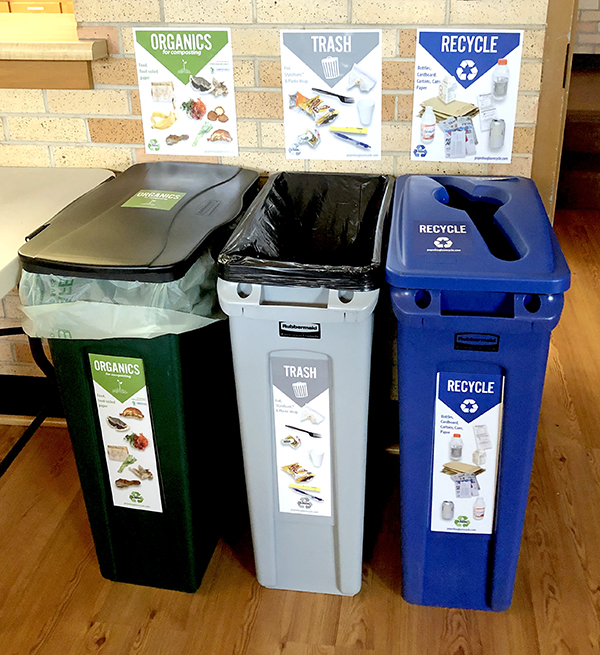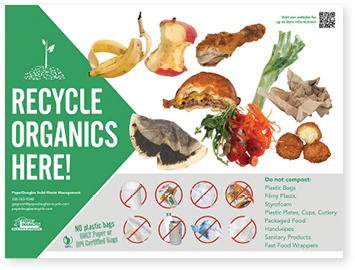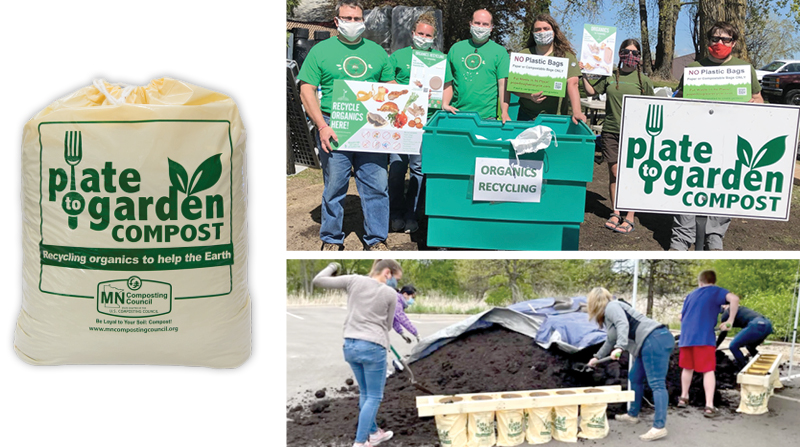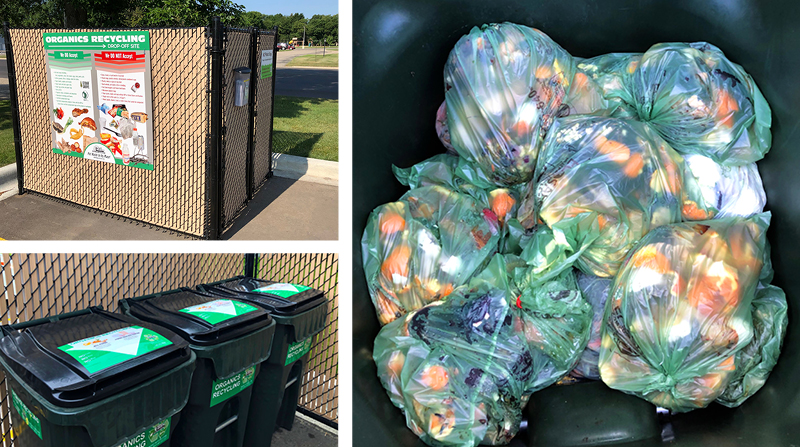Top: The Glacial Ridge Compost Facility in Hoffman, Minnesota is permitted to process 15,000 tons/year of source separated organics. Photo courtesy of Engineered Compost Systems
Nora Goldstein
Pope/Douglas Solid Waste Management (PDSWM), based in Alexandria, Minnesota, is a partnership created by Pope and Douglas Counties in 1983 to manage the municipal solid waste (MSW) stream generated in both counties. Approximately 80,000 tons/year of MSW are received from a 7-county area at PDSWM’s Material Recovery Facility (MRF) and an adjoining Resource Recovery Facility (a waste-to-energy plant). The MRF preprocesses incoming trash via mechanical and human sorting to recover recycled materials, including corrugated cardboard, ferrous and nonferrous metals and wire. Hazardous wastes are also removed, and then the sorted MSW is combusted at the Resource Recovery Facility. In 2023, PDSWM will be building a new Advanced Materials Recovery Facility designed to pull additional items out of the raw MSW stream as well as sort single stream recyclables collected curbside and at drop-off centers.

Separated food waste, soiled paper and BPI-certified compostable products can be placed in the organics bin (on left) at the 3-stream sorting station. Photos courtesy of PDSWM
Food scraps and nonrecyclable paper comprise up to 30% of total MSW generated in Pope and Douglas Counties. There are several small yard trimmings composting sites in the two counties. In 2017, a pilot program was initiated to collect source separated organics (SSO) from several schools and businesses in Pope and Douglas Counties. All food scraps, uncoated paper and BPI-certified compostable liner bags and products were accepted for the pilot. Collected organics were brought to Tri-County Organics in St. Cloud (MN) to be composted. In addition, several residential food waste drop-off sites were established.
During the pilot, PDSWM began laying the groundwork for a SSO composting facility that would service its two counties, as well other counties in the region. “We designed it as a regional facility capable of servicing our needs as well as nearby rural counties,” explains Steve Vrchota, PDSWM’s Executive Director. “We’ve established a partnership with Grant, Stevens and Otter Tail counties to utilize the facility. PDSWM is doing SSO collection from businesses and institutions in our counties; partner counties are working with their local haulers. This approach provides enough density in terms of food waste volumes coming to the composting facility. We expect a minimum of 2,000 tons in the short term of just SSO and as much as 10,000 tons from nearby counties that might make sense to bring in, which would include ground yard trimmings.”
 Grants are available to businesses and institutions to procure bins and signage for organics collection. PDSWM is providing collection at no cost at this time. “Participation is voluntary, but within the next few years, we foresee making commercial organics recycling a requirement via an ordinance,” adds Vrchota. In 2021, 414 tons of organics were collected through the Pope/Douglas Organics Collection program. Additional organics in the two counties are collected through third-party haulers for food-to-animal feeding, food-to-people donation, grease/bone/meat rendering facilities, or big-box store contracts. The total organics recovery rate for Pope and Douglas Counties is approximately 10.4% (1.5% of which is from the current Pope/Douglas Organics Collection program).
Grants are available to businesses and institutions to procure bins and signage for organics collection. PDSWM is providing collection at no cost at this time. “Participation is voluntary, but within the next few years, we foresee making commercial organics recycling a requirement via an ordinance,” adds Vrchota. In 2021, 414 tons of organics were collected through the Pope/Douglas Organics Collection program. Additional organics in the two counties are collected through third-party haulers for food-to-animal feeding, food-to-people donation, grease/bone/meat rendering facilities, or big-box store contracts. The total organics recovery rate for Pope and Douglas Counties is approximately 10.4% (1.5% of which is from the current Pope/Douglas Organics Collection program).
Currently, PDSWM has nine food scraps drop-off sites for households, with another one to open soon. Tons collected from the drop-off sites are not tracked on a consistent basis. However, PDSWM conducts bi-annual audits for all commercial organics customers and organics drop-off sites to measure performance. When commercial organics are collected, the drivers report contamination and other concerns back to PDSWM, so that additional communication can be given to the generator to take corrective action.
Historically, publicly-owned waste-to-energy (WTE) facilities did not embrace SSO recycling programs and utilized put-or-pay contracts that sometimes did not allow them to be established (in order to maximize the MSW flow to the WTE plant). PDSWM, on the other hand, would prefer not to have the wet organics coming to its Resource Recovery Facility. “There is a notion that WTE plants want everything and need to feed the beast,” notes Nathan Reinbold, PDSWM’s Environmental Coordinator. “We would rather have drier material. From our standpoint, the WTE facility can meet its capacity with good burning garbage. There is no incentive to bring in marginal waste.”
Organics Transfer Station And Composting Facility
Construction of the Organics Transfer Station, part of the planned Glacial Ridge Compost Facility, began in 2020. A fabric-covered hoop structure was built to receive incoming SSO, as well as to house the active composting phase. PDSWM selected Engineered Compost Systems (ECS) to design and install a bunker-style aerated static pile composting system. The site will be permitted to process up to 15,000 tons/year within a projected 10- to 15-year timeframe. “The initial build-out is designed to process 2,500 tons/year, including yard trimmings, and then doubling that over the next four to five years,” says Reinbold. “The current building is sized to handle up to 6,000 tons using some of the nonbunkered areas and outside windrows for final curing. Active composting is taking place under cover to manage run-off water. Final curing will be done on a pad outside.” (Minnesota composting regulations categorize water draining from active compost piles as contact water that must be managed as leachate. Covering the active piles minimizes generation of contact water.)
The composting system is being installed in several phases. The initial phase (1A) includes four positive zones (East side) with 22-day retention in active composting (up to 25 days in winter), explains Baraka Poulin with ECS. “These zones are designed for future conversion to reversing aeration that enables the system to recirculate air, which conserves thermal energy during the winter and allows cold piles to heat up much more rapidly. Four additional unaerated zones are being installed on the west side of the building for curing. For future expansion, we included the below grade hardware during this concrete pour, but have not connected aeration ducts during Phase 1A.”
Phase 1B involves adding above grade positive aeration infrastructure to the four west side zones. Phase 2 will require expanding the pad space and covered area, and will include an additional four zones to the east and west sides, for a total of 16 zones of active composting capacity. The zones on the east side are planned to be upgraded to reversing recirculating aeration. “Because of the installed square footage of the building, initially, it doesn’t matter if composting takes longer during the winter using only positive aeration,” says Vrchota. “We know our approximate incoming volume and growth rate, so this phased in approach works well for our needs. We didn’t want to overbuild initially but instead, grow the processing capacity over time. There is space at the site to grow linearly to the north if we need more capacity.”
PDSWM received a 50:50 matching grant from the State of Minnesota for facility construction. While the building frame is complete, construction of the outdoor curing, screening and storage area is paused until the spring when the weather is more favorable for this work. “We anticipate being fully operational shortly after that work is done,” adds Vrchota.

The Plate to Garden Compost program works with youth groups (top) to bag and distribute compost. Bags are filled by hand.
Incoming food waste and other separated organics will be mixed with ground yard trimmings and wood chips using a front-end loader, and then placed in the aerated bunkers. PDSWM will use a contract grinder as needed for additional amendment. It owns a trommel screen to produce half-inch and quarter-inch compost. “Initially, we are working with landscapers and garden centers to sell compost in bulk,” notes Reinbold. “We also are working with the counties to supply compost for road projects. And PDSWM is part of the Minnesota Composting Council’s ‘Plate to Garden’ compost marketing program, where we work with youth groups to distribute compost.”














